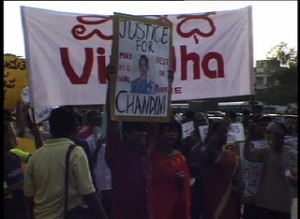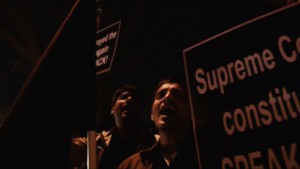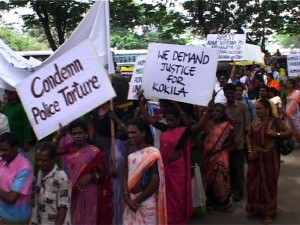
Part 1. T. Jayashree
QAMRA (Queer Archive for Memory Reflection and Activism) as the name suggests, is a gender and sexual minorities archive in India. It is a physical archive, located in the southern city of Bangalore. While preserving memories through collecting and collating multimedia material, the archive aims to be a living one, creating and furthering activism around gender and queer issues. The idea of this archive emerged from the audio/video material I have been collecting since 2001.
The year 1999-2000 was an interesting year for human rights activism in India. India had opened up its economy a few years earlier and tested its nuclear prowess. This was the time the BJP was in power for the first time since independence. Many small groups and organisations were established around this time. My engagement with filming sexual minority communities started with the beginnings of the Bangalore-based NGO Sangama, which served as a documentation and drop-in centre especially catering to the non-English-speaking community.
As more and more people identifying as hijra and kothi started coming to Sangama, the organisation came under the radar of the local police. The outreach effort also revealed that most of the community lived in a state of crisis. There were lesbian couples from out of state, mostly neighbouring Kerala and Tamil Nadu, who came seeking refuge. There was an atmosphere of fear, yet at the same time the need to confront and fight for basic human rights became urgent.
One of the earliest protests in 2002 focussed on what came to be known as the Chandini murder case. Chandini, a transgender woman, had been murdered by her partner and the local police had refused to register a case of homicide, instead declaring that she had committed suicide. For the first time, transgender women took to the streets, and I filmed the protest. At the end of the rally, in front of Town Hall in Bangalore, (late) activist Kajal said, “I am a bisexual hijra and today, while we seek justice for Chandini, we also demand the repeal of section 377.”

The following years saw an escalation in police violence against sexual minorities. As a result, activism strengthened as well. In December 2003, there was a massive rally demanding the repeal of section 377 of the Indian Penal Code, the law that criminalises homosexuality in India.

This was when the Supreme Court ordered the Delhi High Court to hear the NGO Naz Foundation’s petition challenging section 377. As a result, ‘Voices Against 377’, a coalition of groups that represent a wide range of the community, came together. In 2004, Kokila – a Hijra sex worker who was gang-raped by her client and his friends and later brutally assaulted by the police investigating the case at the Bypanahalli police station, Bangalore – decided to openly name the culprits. The massive protest that followed demanding justice for Kokila became a rallying point for the repeal of section 377. Her testimony was included in the Supreme Court petition.

This protest was pivotal for the transgender and hijra communities to actually organise into a movement and to build solidarity with the sex workers’ coalitions and other human rights groups. As activist Umesh recalls, “With our intervention in the Kokila incident, the community found that they can depend on us, they felt that we have a voice, we have someone to support us in our struggle…we had many groups supporting us, because for a year before we had slowly begun coming out in the open and raising our issues in public forums…”
Some of the footage from this protest was edited into the film ‘Many People Many Desires’ (2004), and the documenting of various events and protests continued. Some of the rare footage that I have is of the first Bangalore Pride March in 2008, and conversations between activists who are no longer with us.
In July 2009, the Delhi High court pronounced the verdict on section 377 –decriminalising same sex relationship amongst consenting adults in India. Within weeks, this verdict was challenged in the Supreme Court by various religious groups and individuals. The Supreme Court heard the case in 2012.
The arguments in the court, from the transcript sent by lawyers from the Alternative Law Forum, clearly indicated a shift in the reasoning of the arguments from the High Court hearing and the attitude of the judges in emphasising the sexual act rather than sexual identity. I started following the petitioners and lawyers who worked on the case, while waiting for the judgment to be pronounced. This set of filming was done with the intention of recording memories within the court-room and outside of it.
The Supreme Court reversed the order and recriminalised section 377 in 2014. There was outrage everywhere – disbelief and a sense of betrayal.
In the following months, there were many vigils and protests, which culminated in a global day of rage across the world. The footage from various places was edited into a short video to launch a public campaign on the Right to Dignity. The aftermath also saw an increase in cases of violence, which was carefully documented by various activists.
Looking at the transcript of the judgment, I wondered about all those lives, struggles, and stories that I had been recording. Thousands of gigabytes of footage that I have collected over a decade and a half – how does one make sense of it? Can these stories of intimacy, events, protests, anger, disappointment, violence, desire, and loneliness be translated into the realm of visual jurisprudence? What could be the role of such documentary films and footage?
The question before me was: do I make another film with all this material? As I look through the footage, I realise that most of the interviews I have comprise of oral histories of individuals and their families. One thing that struck me is that the major concern of the queer community in India is still the issue of family and stigma. Then there is the issue of mental health and suicide. While the community has undergone a major shift in identifying and expressing the myriad spectrums of gender and sexual expressions, the tensions continue to be the same. Crisis seems to be a major player in the lives of queer people.
As video artist, activist, and academic Alexandra Juhasz describes her experimental videotape Video Remains (2004), “…It (the footage) is like making grief, anger, and nostalgia into something present, public, communal, and active.”
Part 2. Siddharth Narrain
A significant part of QAMRA is material related to the legal struggle to decriminalize homosexuality in India and the court challenge to section 377 of the Indian Penal Code, the law that criminalizes “carnal intercourse against the order of nature”. When the Supreme Court in 2014 recriminalized homosexuality, and overturned the Naz Foundation judgment, one of the main grounds was that there was not enough documentation related to discrimination and rights violations alleged, and that there was nothing called an “LGBT community”, just a bunch of individuals who may identify as LGBT. The QAMRA archive then, through documenting queer lives and struggles, forms the basis for more documentation, as well as helps create this idea of a community.
The institutional history of the LGBT community is crucial in reconstructing the specific challenges that were faced, and even watching the video footage 15 years later, one gets a sense of the enormous changes that have taken place since then. Much of the material in the archive is video footage dating back to the early 2000s and situated in Bangalore. The banners (“Repeal section 377”) and slogans (“Beku Beku Nyaya Beku”, “We Want Justice”) may remain the same, but many of the prominent faces, the way in which activists pose in front of the camera, and the composition of the public in protests and marches have changed dramatically.
One reading of the judicial process in the 377 case so far has been that of the failure to decriminalise. But one could argue that in fact, the legal process has been productive in more ways than one. The legal case so far has consolidated a certain form of meaning making (the use of identity; the foregrounding of privacy, dignity, liberty, and equality; the ideal of inclusive citizenship; and that of constitutional morality).
The legal process has produced an archive of affidavits, court transcripts, pleadings, interviews, media reportage, public messaging, TV programs, news clippings, opinion pieces, photographs, legal writing, and a queer legal public sphere that continue to influence public and intellectual discourse, and has helped create a conducive atmosphere for a rehearing of the case – as the decision is largely being seen as irrational, and a step backward for the judiciary and rights discourse in the country
It is this larger legal archive that QAMRA will both feed into and draw upon, by archiving this contemporary legal struggle; through interviews, physical objects, legal documents etc, it will help make obvious this connection that runs through the judicial proceeding and spills over into the social, mediated through news channels, print media, blogs, Twitter feeds, NGOs, e-mail chains, and, increasingly, WhatsApp groups.
In that sense could we see QAMRA as a continuation of, or at least overlapping with, the legal archive. Could we imagine QAMRA as an archive that is alive, and interventionist, that is enabling the creation of a new space for dialogue while assiduously documenting the lives, work and interventions of existing and older histories?
The challenge is now on giving a perspective to the material in QAMRA. Can these videos of Queer activism be translated into a further collective action? Will they provide visual and auditory support for future actions, both in terms of activism as well as for legal battles? One can envisage this as the audio-visual evidence collected through this archive being introduced in the courtroom directly, or having a more indirect long-term impact on the discourse around sexuality, which will then influence judicial attitudes towards the subject.
As the first part of this article points out, QAMRA is imagined as an archive that goes much beyond the legal challenge to 377, and aims to document a broader canvas of queer activism in India The purpose of this archive is also to make it a ‘living’ archive – not just to recreate nostalgia. The material in QAMRA is about the public history of the movement, but the focus is also on private lives of individuals, of which there is very little existing documentation.
In going about this task, we hope that this archive will serve both as a repository of collective memory and platform for collective action.